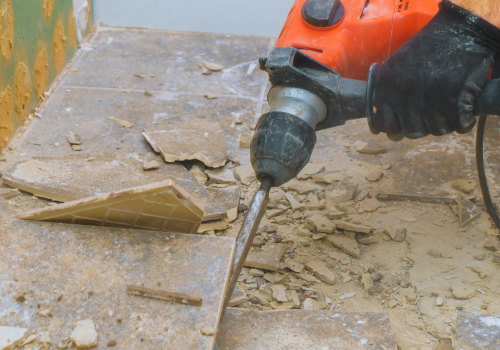When it comes to renovating or upgrading small residential spaces, demolition is often the first and most crucial step. Properly planning and executing a demolition can set the stage for a successful transformation. Whether you’re aiming to create an open-concept living area, update outdated fixtures, or simply reconfigure your space, understanding the nuances of demolition in a compact setting is essential. This process involves more than just tearing down walls; it requires a strategic approach to ensure safety, efficiency, and minimal disruption. In this guide, we’ll walk you through essential demolition tips tailored for small residential areas. From assessing structural integrity and managing debris to employing the right tools and techniques, our tips will help you navigate the demolition phase with confidence. With careful preparation and attention to detail, you can make the most of your small space renovation project, turning your vision into a reality.
Demolition projects can be complex and risky endeavors, but with meticulous planning, you can ensure that your project proceeds smoothly and safely. Whether you’re demolishing a small structure or a large building, a thorough plan is essential for minimizing risks, staying on budget, and achieving your goals efficiently. Here are eight key steps to consider when planning your demolition project:
Before diving into the demolition process, clearly outline the project’s scope and objectives. What specific structures or parts need to be demolished? Are there any components that need to be preserved or salvaged? Define the project goals, such as whether you’re clearing land for new construction, renovating a space, or removing hazardous materials. A detailed scope will guide all subsequent planning and ensure that all stakeholders are aligned.

A comprehensive site assessment is crucial for identifying potential hazards and understanding the conditions of the structure(s) to be demolished. Inspect the site for structural stability, hazardous materials (such as asbestos or lead), utility lines, and neighboring properties. A professional inspection may be necessary to uncover hidden issues. This assessment will help you develop a safe and effective demolition strategy.
Demolition projects often require permits and approvals from local authorities. These permits ensure that your demolition activities comply with local building codes, safety regulations, and environmental standards. Contact your local government or regulatory body to determine what permits are required and the application process. Failure to obtain the necessary permits can lead to fines, work stoppages, and legal complications.
Create a detailed demolition plan outlining the methods and techniques to be used. Decide whether you will use manual or mechanical demolition, or a combination of both. Consider the type of equipment needed, such as excavators, bulldozers, or wrecking balls. Your plan should also include a timeline, budget, and safety measures. A well-developed plan will help you execute the project efficiently and minimize disruptions.
Proper waste management is a critical component of any demolition project. Plan how you will handle and dispose of debris, including recycling or salvaging materials where possible. Identify local disposal facilities and understand their requirements. Some materials may need to be sorted or treated before disposal. Efficient waste management reduces environmental impact and can even offset some project costs through recycling.
In any demolition project, safety should always be the top priority. The demolition environment is inherently hazardous, with risks including falling debris, exposure to toxic substances, and heavy machinery operations. To mitigate these risks and ensure the well-being of all workers and bystanders, it’s crucial to implement the proper safety gear and precautions. Below are eight essential safety measures and equipment that should be in place for a safe demolition process:
Personal Protective Equipment (PPE) is the first line of defense against injury on a demolition site. Essential PPE includes hard hats, safety goggles, gloves, and steel-toed boots. Hard hats protect against falling objects, while safety goggles shield the eyes from dust and debris. Heavy-duty gloves provide hand protection against sharp materials and machinery, and steel-toed boots safeguard the feet from heavy falling objects. Depending on the specific risks of the demolition site, additional PPE such as earplugs, respirators, and high-visibility vests may also be necessary.
Demolition work often involves exposure to dust, asbestos, and other airborne contaminants. Respirators and masks are crucial for protecting workers’ respiratory health. Depending on the materials being demolished, you may need specific types of respiratory protection, such as N95 respirators for fine dust or specialized filters for hazardous substances like asbestos. Ensure that all respiratory equipment is properly fitted and maintained to provide effective protection.
demolition tasks involve working at heights, which increases the risk of falls. To mitigate this risk, implement fall protection measures such as harnesses, lanyards, and safety nets. Workers should be trained in proper use and maintenance of fall protection equipment. Ensure that all elevated work areas have guardrails or other safety barriers in place. Regularly inspect fall protection systems to ensure their integrity and effectiveness.
Demolition sites can be extremely noisy, especially with heavy machinery in use. Prolonged exposure to high noise levels can lead to hearing damage or loss. Hearing protection, such as earplugs or earmuffs, is essential to safeguard workers’ auditory health. Choose hearing protection that provides adequate noise reduction and ensure that workers use it consistently throughout the project.
Safety on a demolition site is greatly enhanced by ensuring that all workers are adequately trained and supervised. Training should cover the safe operation of equipment, emergency procedures, and hazard recognition. Supervisors should be experienced and knowledgeable, overseeing operations to ensure compliance with safety protocols. Regular safety briefings and updates should be conducted to address any new hazards or changes in the work environment.
Selecting the right tools is crucial for a successful and efficient demolition project. Using the appropriate tools not only speeds up the work but also ensures safety and accuracy. Here’s a quick guide to choosing the right tools for your demolition needs:
Demolishing small residential spaces can be a challenging yet rewarding endeavor. By following the tips outlined—such as meticulous planning, prioritizing safety, and using the right tools—you can ensure a smoother process and achieve optimal results. Remember, preparation is key to avoiding unnecessary complications and expenses. Whether you’re tackling a bathroom remodel or clearing out a cramped attic, a strategic approach will make all the difference.
If you need professional assistance to handle the job efficiently, JUNKAHAULICS – Raleigh is here to help. Our team is equipped with the expertise and tools necessary to manage your demolition project safely and effectively. Contact us today at (910) 403-3616 or visit us at 4801 Glenwood Ave, Suite 200, Raleigh, NC 27612. Let us make your demolition project a success!


JUNKAHAULICS